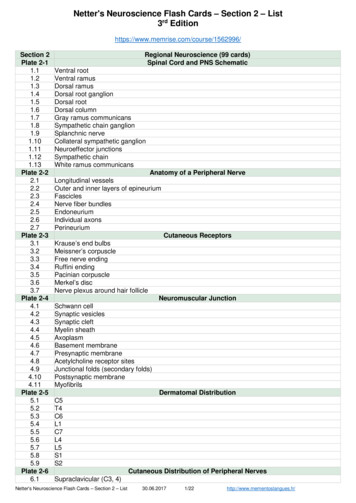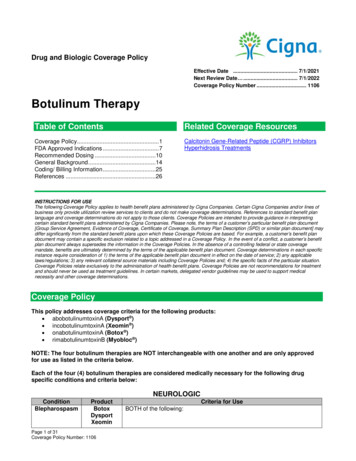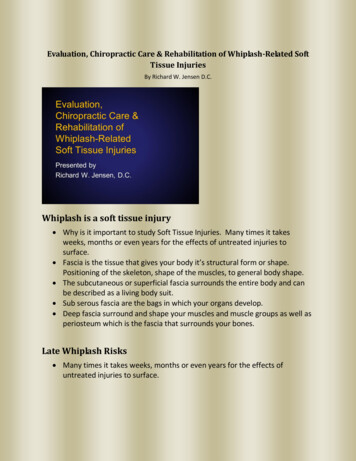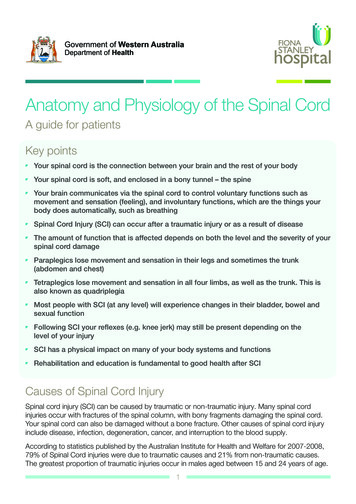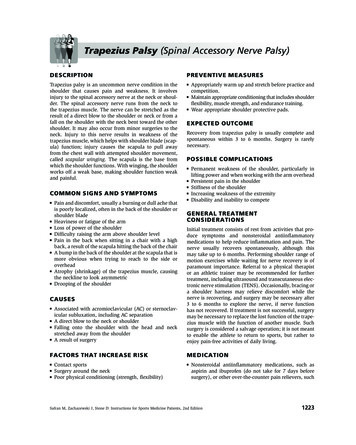
Transcription
Trapezius Palsy (Spinal Accessory Nerve Palsy)DESCRIPTIONTrapezius palsy is an uncommon nerve condition in theshoulder that causes pain and weakness. It involvesinjury to the spinal accessory nerve at the neck or shoulder. The spinal accessory nerve runs from the neck tothe trapezius muscle. The nerve can be stretched as theresult of a direct blow to the shoulder or neck or from afall on the shoulder with the neck bent toward the othershoulder. It may also occur from minor surgeries to theneck. Injury to this nerve results in weakness of thetrapezius muscle, which helps with shoulder blade (scapula) function; injury causes the scapula to pull awayfrom the chest wall with attempted shoulder movement,called scapular winging. The scapula is the base fromwhich the shoulder functions. With winging, the shoulderworks off a weak base, making shoulder function weakand painful.COMMON SIGNS AND SYMPTOMSPain and discomfort, usually a burning or dull ache thatis poorly localized, often in the back of the shoulder orshoulder bladeHeaviness or fatigue of the armLoss of power of the shoulderDifficulty raising the arm above shoulder levelPain in the back when sitting in a chair with a highback, a result of the scapula hitting the back of the chairA bump in the back of the shoulder at the scapula that ismore obvious when trying to reach to the side oroverheadAtrophy (shrinkage) of the trapezius muscle, causingthe neckline to look asymmetricDrooping of the shoulderCAUSESAssociated with acromioclavicular (AC) or sternoclavicular subluxation, including AC separationA direct blow to the neck or shoulderFalling onto the shoulder with the head and neckstretched away from the shoulderA result of surgeryFACTORS THAT INCREASE RISKContact sportsSurgery around the neckPoor physical conditioning (strength, flexibility)PREVENTIVE MEASURESAppropriately warm up and stretch before practice andcompetition.Maintain appropriate conditioning that includes shoulderflexibility, muscle strength, and endurance training.Wear appropriate shoulder protective pads.EXPECTED OUTCOMERecovery from trapezius palsy is usually complete andspontaneous within 3 to 6 months. Surgery is rarelynecessary.POSSIBLE COMPLICATIONSPermanent weakness of the shoulder, particularly inlifting power and when working with the arm overheadPersistent pain in the shoulderStiffness of the shoulderIncreasing weakness of the extremityDisability and inability to competeGENERAL TREATMENTCONSIDERATIONSInitial treatment consists of rest from activities that produce symptoms and nonsteroidal antiinflammatorymedications to help reduce inflammation and pain. Thenerve usually recovers spontaneously, although thismay take up to 6 months. Performing shoulder range ofmotion exercises while waiting for nerve recovery is ofparamount importance. Referral to a physical therapistor an athletic trainer may be recommended for furthertreatment, including ultrasound and transcutaneous electronic nerve stimulation (TENS). Occasionally, bracing ora shoulder harness may relieve discomfort while thenerve is recovering, and surgery may be necessary after3 to 6 months to explore the nerve, if nerve functionhas not recovered. If treatment is not successful, surgerymay be necessary to replace the lost function of the trapezius muscle with the function of another muscle. Suchsurgery is considered a salvage operation; it is not meantto enable the athlete to return to sports, but rather toenjoy pain-free activities of daily living.MEDICATIONNonsteroidal antiinflammatory medications, such asaspirin and ibuprofen (do not take for 7 days beforesurgery), or other over-the-counter pain relievers, suchSafran M, Zachazewski J, Stone D: Instructions for Sports Medicine Patients, 2nd Edition1223
1224TRAPEZIUS PALSYas acetaminophen, are often recommended. Take theseas directed by your physician, and contact your doctorimmediately if any bleeding, stomach upset, or signs ofan allergic reaction occur.Stronger pain relievers may be prescribed by yourphysician, usually only after surgery. Use these onlyas directed, and take only as much as you need.HEAT AND COLDCold is used to relieve pain and reduce inflammationfor acute and chronic cases. It should be applied for10 to 15 minutes every 2 to 3 hours as needed andimmediately after any activity that aggravates yoursymptoms. Use ice packs or an ice massage.Heat may be used before performing stretching andstrengthening activities prescribed by your physician,physical therapist, or athletic trainer. Use a heat packor a warm soak.R A N G E O F MO T I O NAND STRETCHING EXERCISESTrapezius PalsyThese are some of the initial exercises you may use tostart your rehabilitation program, until you see yourphysician, physical therapist, or athletic trainer again,or until your symptoms resolve. Please remember:Flexible tissue is more tolerant of the stresses placedon it.A gentle stretching sensation should be felt.WHEN TO CALL YOUR DOCTORSymptoms get worse or do not improve in 6 weeksdespite treatment.New, unexplained symptoms develop. Drugs used intreatment may produce side effects.RANGE OF MOTION Shoulder Flexion,Single Arm1. Lie on your back. Grasp the bottom of a stick, handle ofan umbrella, or blade of a golf club in your hand asshown.2. Using the stick, raise your arm overhead as shown,until you feel a gentle stretch. Lead with your thumbin a “thumbs up” position.3. Hold each repetition for seconds, and return tothe starting position.4. Repeat this exercise times, times per day.FIGURE 1 From Rockwood CA Jr, Matsen FA III: The shoulder,ed 2, Philadelphia, 1998, W.B. Saunders, p 54.Copyright 2012 by Saunders, an imprint of Elsevier, Inc.
TRAPEZIUS PALSYRANGE OF MOTION Shoulder Flexion,Double Arm1. Lie on your back holding a stick in both hands, keepingyour hands shoulder width apart.2. Raise both hands over your head, until you feel a gentlestretch.3. Hold each repetition for seconds, and return tothe starting position.RANGE OF MOTION1225Shoulder Flexion1. Sit in a chair with your weak arm on a table as shown.2. Lean forward slowly, sliding your arm forward on thetable, until you feel a gentle stretch.3. Hold each repetition for seconds, and return tothe starting position.4. Repeat this exercise times, times per day.4. Repeat this exercise times, times per day.RANGE OF MOTION Shoulder Abduction,Single ArmRANGE OF MOTION Shoulder ExternalRotation1. Lie on your back holding a stick, umbrella handle, orgolf club in your hand as shown. Your hand should bein a “thumbs up” position.1. Lie on your back or stand with your weak arm at yourside and your elbow bent to 90 degrees. Hold a stick,umbrella handle, or golf club in your hands as shown.2. Using the stick, slowly push your arm away from yourside and as far overhead as you can without pain. Pushuntil you feel a gentle stretch.2. Using the stick, rotate your hand and forearm awayfrom your body as shown. Make sure you keep yourupper arm and elbow at your side.3. Hold each repetition for seconds, and return tothe starting position.3. Hold each repetition for seconds, and return tothe starting position.4. Repeat this exercise times, times per day.4. Repeat this exercise times, times per day.Safran M, Zachazewski J, Stone D: Instructions for Sports Medicine Patients, 2nd Edition
1226TRAPEZIUS PALSYRANGE OF MOTION Shoulder InternalRotation1. Place the hand of your weak arm behind your back.2. Drape a towel over your opposite shoulder, and graspit with the hand that is behind your back.3. Use the towel to slowly pull your hand farther up yourback, until you feel a gentle stretch.4. Hold each repetition for seconds, then return tothe starting position.5. Repeat this exercise times, times per day.S TR E N G T H E N I N G E X E R C I S E STrapezius PalsyThese are some of the initial exercises you may use tostart your rehabilitation program, until you see yourphysician, physical therapist, or athletic trainer again,or until your symptoms resolve. Please remember:STRENGTHScapular Elevation, Shrugs1. Stand in a good, erect posture with your arms at yoursides.2. Gently shrug your shoulders up and back toward yourears.3. Hold this position for seconds, and slowly returnto the starting position.4. Repeat this exercise times, times per day.You may perform this exercise with a pound weightin each hand. Avoid standing in a slouched position withpoor posture by using this technique throughout the day.Strong muscles with good endurance tolerate stressbetter.Do the exercises as initially prescribed by your physician, physical therapist, or athletic trainer. Progressslowly with each exercise under their guidance, gradually increasing the number of repetitions andweight used.Copyright 2012 by Saunders, an imprint of Elsevier, Inc.
TRAPEZIUS PALSYSTRENGTHShoulder Abduction,Isometric1. Stand and raise your weak arm slightly away fromyour body as shown.2. Place your other hand on top of your arm, and pushdown as hard as you can without having any painand without moving your arm.3. Hold this position for seconds, and slowly returnto the starting position.STRENGTH1227Shoulder External Rotation1. Lie on your side with your weak arm up and yourelbow bent to 90 degrees, or stand with your arms atyour sides with your elbows bent to 90 degrees asshown. Place a small rubber ball (4 to 6 inches indiameter) or a rolled-up towel between your elbowand your side as shown.2. Hold a pound weight in your hand, and turn yourarm up toward the ceiling, keeping your elbow bent asshown. If using a rubber band/tubing, turn your armsout from your sides, keeping your elbows bent.4. Repeat this exercise times, times per day.3. Do this slowly, and maintain control through yourpain-free range of motion. If this is painful, stop anddiscuss this with your physician, physical therapist,or athletic trainer.4. Hold this position for seconds, and slowly returnto the starting position.5. Repeat this exercise times, times per day.STRENGTHShoulder Flexion, Isometric1. Stand and raise your weak arm straight in front of youas shown.2. Place your other hand on top of your arm, and push ashard as you can without having any pain and withoutmoving your arm.3. Hold this position for seconds, and slowly returnto the starting position.4. Repeat this exercise times, times per day.Safran M, Zachazewski J, Stone D: Instructions for Sports Medicine Patients, 2nd Edition
1228TRAPEZIUS PALSYSTRENGTHShoulder Internal Rotation1. Anchor a rubber band/tubing to a heavy, stable objectas shown.2. Place a small ball (4 to 6 inches in diameter) or arolled-up towel between your elbow and body asshown, and bend your elbow to 90 degrees.3. Squeeze the ball gently to your side with your elbow.4. Rotate your arm in toward your body and across yourchest and stomach. Do not let the ball move away fromyour side.5. Hold this position for seconds, and slowly returnto the starting position.6. Repeat this exercise times, times per day.STRENGTHShoulder Extension1. Anchor a rubber band/tubing around a stable object,such as a stair post, or around the knob of a closeddoor.2. Stand holding the rubber band/tubing in front of youwith your arms extended as shown.3. Squeeze your shoulder blades together, and pull yourarms down and backward as shown. Do not pull yourarms past the midline of your body.4. Hold this position for seconds, and slowly returnto the starting position.5. Repeat this exercise times, times per day.Copyright 2012 by Saunders, an imprint of Elsevier, Inc.
TRAPEZIUS PALSYSTRENGTH1229Scapula Retraction/Elevation1. Lie on your stomach on a bed with your weak arm overthe edge of the bed as shown, holding a poundweight in your hand.2. Raise your arm up slowly in front of you, so that it islevel with the edge of the bed. Keep your elbowstraight.3. Hold this position for seconds, and slowly returnto the starting position.4. Repeat this exercise times, times per day.STRENGTHShoulder HorizontalAbduction1. If using a weight: Lie on your stomach on a bed withyour weak arm over the edge as shown, holding apound weight in your hand.2. Raise your arm up slowly as shown, so that it is levelwith the edge of the bed. Keep your elbow straight.3. Hold this position for seconds, and slowly returnto the starting position.4. Repeat this exercise times, times per day.1. If using a rubber band/tubing: Anchor the rubberband/tubing to a fixed object.2. Hold one end of the band/tubing in each hand asshown, with your arms straight out in front of you.3. Spread your arms apart, pulling straight backward,keeping your arms parallel to the floor.4. Hold this position for seconds, and slowly returnto the starting position.5. Repeat this exercise times, times per day.Safran M, Zachazewski J, Stone D: Instructions for Sports Medicine Patients, 2nd Edition
1230TRAPEZIUS PALSYSTRENGTHShoulder Extension1. Lie on your stomach on a bed with your weak arm offthe edge of the bed.2. Holding a pound weight in your hand, slowlyraise your arm up and backward toward the ceiling.3. Hold this position for seconds, and slowly returnto the starting position.4. Repeat this exercise times, times per day.Copyright 2012 by Saunders, an imprint of Elsevier, Inc.
discuss this with your physician, physical therapist, or athletic trainer. 4. Hold this position for _ seconds, and slowly return to the starting position. 5. Repeat this exercise _ times, _ times per day. TRAPEZIUS PALSY 1227 Safran M, Zachazewski J, Stone D: Instructions for Sports Medicine Patients, 2nd Edition
